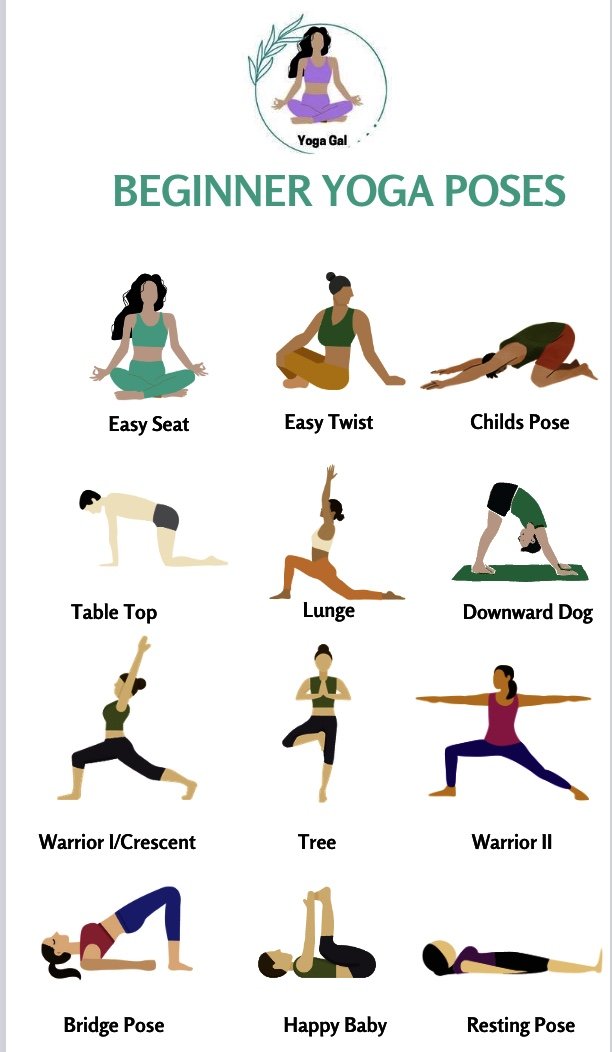Yoga for Beginners
If you are ready to try yoga, but you have NO IDEA how it works, this guide is for YOU! Yoga can be intimidating because of the unusual shapes of the poses and their unfamiliar Sanskrit names. However, many teachers use English accompanied by the Sanskrit for educational purposes. As a student, you do not need to know the translation and many teachers do not even use it. Once you learn some of the basic yoga poses, yoga cam be a beautiful practice with multiple benefits.
Here are 12 Basic poses for Beginners:
Easy Pose/Sukhasana: is a seated pose used at the beginning and/or at the end of class for breath work and meditation. It is meant to find the balance between stability and softness and can be used to reduce stress & anxiety.
Come into a seated position with the tailbone on the floor, or seated on a block. Cross the shins and place the feet directly below the knees. Align the neck, shoulders, & hips and elongate the spine to create a clear line of energy from your tailbone to the crown of your head.
Easy Twist/Parivrtta Sukhasana stretches the hips, knees, and ankles. It increases flexibility throughout the spine, shoulders, and chest.
From Easy Pose, elongate your spine and place your right hand on your left knee. Bring your left hand to the floor behind you, exhaling as you gently twist to the left.
Childs Pose/Balasana is a classic resting posture often used at the beginning of class or any time you need a break. Childs pose lengthen’s your spine, opens your hips, and stretches your thighs.
From Table Top, bend your knees and bring your feet together. Let your chest and forehead rest between your hands. Students can modify the pose by putting a block under their head or taking their arm behind them.
Table Top/Bharmanasana: is generally a starting point or a transition posture for many floor postures like cat/cow & downward dog. It helps lengthen and realign the spine.
Start on your hands and knees, with your hands directly under your shoulders and knees under your hips. Keep your spine neutral and engage your core muscles.
Cat/Cow/Bitilasana Marjaryasana: is practiced in combination as a way to warm up the spine.
From the Table Top position, inhale as you arch your back and lift your chest towards the ceiling, dropping your belly towards the floor (Cow Pose). If Cow pose is uncomfortable, remain in table top. Then, Exhale and round your spine, tucking your chin towards your chest and drawing your belly button towards your spine (Cat Pose).
Lunge/Anjaneyasana: stretches the quads & inner thighs and opens the chest.
Step one foot forward and bend your front knee to create a lunge position. Keep your back leg bent and drive both legs into the mat. Then, engage your core, quad, & glutes. You can place your hands on your front knee for support or send them up towards the sky.
Downward Facing Dog/Adho Mukha Shvanasana: is a great pose to stretch and strengthen the entire body, especially the arms, shoulders, hamstrings, and calves.
Start in a table top then lift your hips towards the ceiling while pressing your palms and feet into the ground. Keep your knees bent. Your body will form an inverted "V" shape. Keep your spine straight, heels reaching towards the ground, and head relaxed between your arms.
Mountain Pose/Tadasana: is often used as a starting point for standing postures and standing balance. Mountain pose improves posture because of the stacked alignment of the shoulders, hips, and feet.
Stand tall with your feet hip-width apart. Ground your feet into the floor, engage your leg muscles, lengthen your spine, and roll your shoulders back and down. Relax your arms by your sides.
Warrior 1/Vīrabhadrāsana 1: Stretches and strengthens the feet, ankles, calves and thigh muscles and improves mobility in shoulders and hip joints and opens the chest and lungs.
From Mountain Pose, step one foot back and turn it to a 45 degree angle and your foot turned out. Keep your front foot in line with the long edge of the mat and bend your front knee. Activate your back leg and keep it straight and strong. Extend your arms overhead, palms facing each other.
Warrior 2/Vīrabhadrāsana 2: Stretches the inner thighs, groin, and chest and Strengthens the legs, abs, and arms.
From Warrior 1, open your hips and turn your back foot inline with the short edge of the mat. Extend your arms out to the sides, parallel to the ground. Your front knee should be bent, and your gaze can be towards your front hand.
Bridge Pose: strengthen your back muscles, glutes, and hamstrings and opens your chest, neck, shoulders, & thighs.
Lie on your back with your knees bent and feet flat on the floor, hip-width apart. Press your feet into the ground as you lift your hips towards the ceiling. You can keep your arms overhead or interlace your hands beneath your body for support.
Resting Pose//Savasana: is one of the more challenging yoga poses because of the struggle with stillness. Savasana allows us to Release, Rejuvenate, & Realize what we have just learned in our practice.
Lie flat on your back, arms by your sides, palms facing up. Close your eyes and relax your entire body. Stay in this pose for a few minutes to allow your body and mind to relax.
Remember to listen to your body and modify any poses as needed. To try a class for beginners, join me on Sunday mornings or Thursday evenings in person or online and check out the Yoga Gal Youtube Yoga for Beginners Class.


